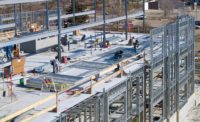Building for Fire Resistance

Photo courtesy of Jim Arabia via Shutterstock
The average passerby likely doesn’t size up a building for its durability. Instead, they look at a structure’s height, function, design and beauty. But in many places, such as southern California, a building’s durability is very often top of mind, particularly in relation to fire.
Wildfires are a realistic threat to construction in many parts of the country, some much more than others. There is an absolute need to prepare for fires with safe, resilient construction.
Areas Vulnerable to Wildfires
Since the year 2000, more than 7 million acres per year have burned across the United States. Between 2005 and 2020, a total of 89,210 structures across the nation were destroyed by fire. With the growing threat of fast-moving flames, building with fire-resistant materials and creating defensible surrounding spaces is incredibly important.
Fires can, of course, flare up anywhere. But large fires, burning 10 acres or more, are far more prevalent in the west than elsewhere in the United States. Hotspots include Arizona, northwest Utah, northern Nevada and southern New Mexico. But the greatest fire danger in recent decades has been in our home state of California. We have seen firsthand the destruction that ensues when a fire rages and burns buildings quickly and unforgivingly, crossing freeways, canyons and even waterways.
Sadly, we witnessed the devastating fire season of 2020, during which more than 40% of the burned acres—as well as many of the 17,000-plus structures—were here in the Golden State.
California’s incendiary conditions are due to the fact that our climate allows the three things fire needs to thrive: fuel, oxygen and heat. The dry conditions of our summers and early fall provide an ideal setting for fires to start and spread.
Building for Fire Resistance
Builders in California know that constructing a fire-resistant structure all starts with using the right materials. Retrofitting, however, is a viable option when existing buildings need safer materials to help them withstand unwelcome blazes.
Building from the ground up using fire-resistant materials involves a few proven options:
- ICF Concrete: Insulated Concrete Forms are expanded polystyrene blocks that stack together. These blocks help prevent fire because their construction allows them to slow the conduction of heat from one side of the wall to the other. ICFs can withstand fire for four hours or more.
- Steel or Metal: A steel or metal roof is fire-resistant and, as a Class A-rated material, is a good material for building a wildfire-resistant ICF structure. It is particularly effective in insulating from sparks, preventing a fire from spreading throughout a building.
- Fire-Resistant Bricks: Bricks made of clay and fired in a kiln have a remarkably high fire resistance rating. They are classified as non-combustible material as well.
- Gypsum Drywall: Gypsum drywall, which is rated for fire specifically, contains glass fiber and is 21% water. When it is exposed to fire, the water is slowly released as steam, helping it resist the fire’s damage.
- Glass: Dual-paned and/or fire-resistant glass windows will double the time it takes a fire to enter a structure. When hot enough, glass will eventually shatter, but two panes will slow down the process, as will tempered glass. Framing windows appropriately is important, too. For example, using internal reinforcement bars can protect vinyl frames from melting and giving way.
- Wood: Fire-resistant wood is available, which contains chemicals that keep it stable when faced with elevated temperatures. This type of wood can slow the spread of fire and resist ignition in the first place.
Defensible Space
Creating a defensible space in the event of a wildfire is critical to slowing the encroachment of the fast-burning flames on your development area. When designing your building plan zone, it is smart to carve out safety zones around the building areas and project out the landscape phase by choosing plants that grow low in profile and are high in moisture but low in resin and sap content. Examples of fire-resistant vegetation include cotoneaster, bush honeysuckle, aloe, ice plant, currant, sumac and shrub apples.
Protect High-Risk Areas
Roofs are obvious vulnerable points on any structure. When building for fire resistance, it is important to add a Class-A-rated roof. Wind-blown debris often accumulates on roofs and in gutters and can be easily ignited by embers blown in from the fire source. Roof materials are rated by the building industry in classes from A to C, with Class A being the most fireproof. Examples of the materials are metal, concrete, slate and clay.
Also, to avoid embers getting inside, exterior vents such as those in an attic or under the eaves should be covered with metal mesh with openings no larger than one-eighth of an inch.
As mentioned above, windows will break from intense heat, allowing embers to enter a building. Large and single-paned windows are vulnerable. It is best to install multi-paned windows and tempered safety glass to protect from breakage and fire intrusion. Also available are fireproof shutters for further protection of this high-risk area.
Exterior-facing walls of a structure are also highly vulnerable to destruction from intense wildfire heat. Building walls with brick, stucco, gypsum or ICF concrete helps add a layer of fire protection. Wood, although commonly used in residential interiors, is highly flammable, although there are fire-resistant types available.
As of June 2022, the burned acreage across the western United States is already well above normal, with more than 1.1 million acres (about twice the area of Yosemite National Park) burned, more than twice the number by this time last year. According to AccuWeather scientists, 2022 will likely have an above normal fire season.
Creating a fire-resistant building starts at the construction stage. From using land clearing equipment to create a defensible space to adding fire-resistant roofing and multi-paned windows, you can minimize the chances of considerable damage from a wildfire in the future by making smart decisions throughout the building process.
Looking for a reprint of this article?
From high-res PDFs to custom plaques, order your copy today!






